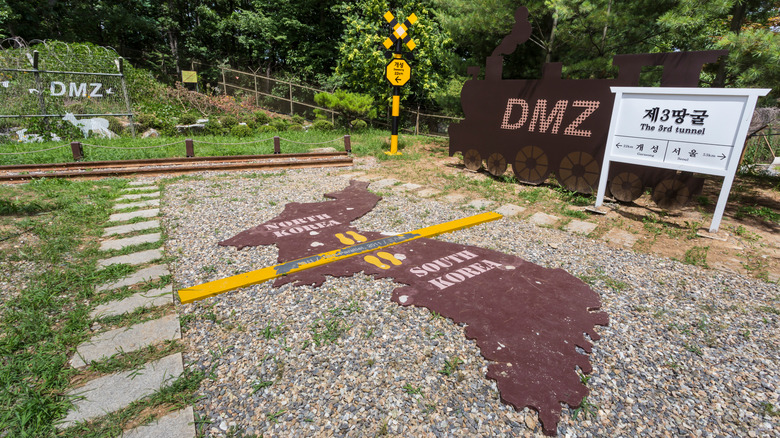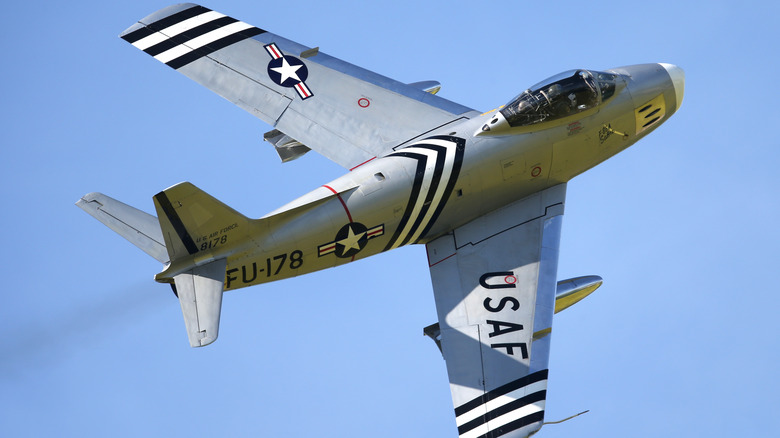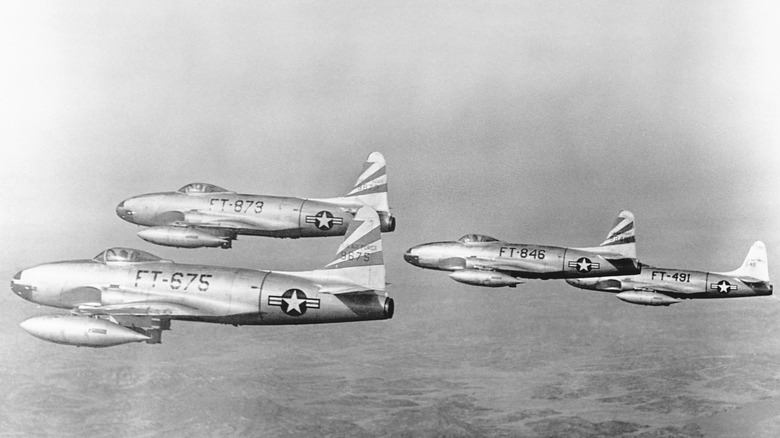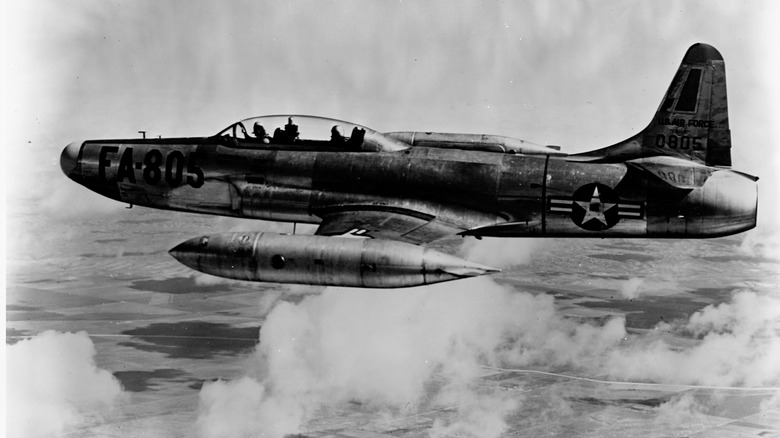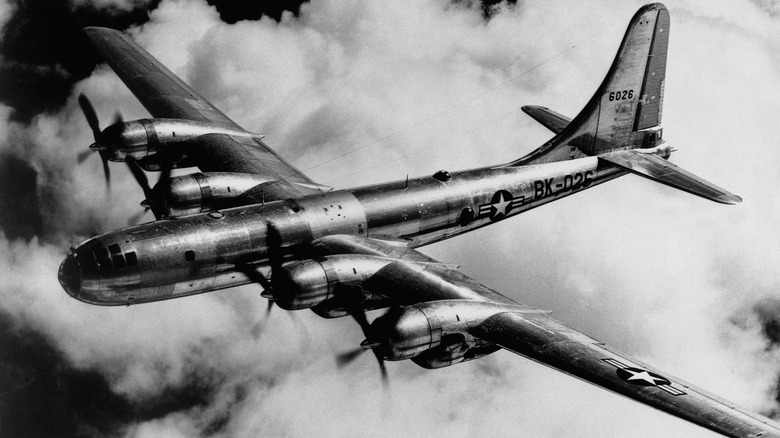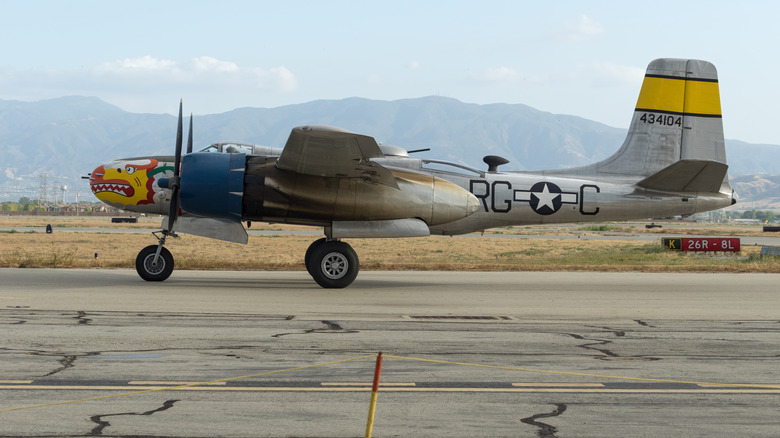5 Of The Most Advanced Planes Used In The Korean War
When the Korean War broke out in 1950, territory rapidly changed hands as assaults and counteroffensives were launched by coalitions in both battle camps over the three years it lasted. Ultimately, an armistice saw an end to fighting with a staunch border adopted at the now famous 38th Parallel. Still, the swift American involvement signaled to Soviet and Chinese supporters of North Korea that further proxy conflict in the region and beyond would be taken very seriously.
Unlike the continental air battles that had taken place in the previous decades, the Korean War was dominated by jet-powered aircraft that were far superior to the piston-propelled models made famous during World War II. It sits as a crossroads between the ways of warfare that came before and the asymmetrical combat that would characterize the Vietnam War. Those serving in Korea had to manage elements of competing and evolving battlefield realities.
The Lockheed F-80 Shooting Star, for instance, was the first aircraft to engage in jet-on-jet dogfighting over Korea, shooting down a Russian MiG-15 in 1950. This wasn't the only newer aircraft to see combat over the Korean Peninsula though. Many novel aerial vessels took flight during these years. These are five of the most technologically impressive to lend their service.
North American F-86 Sabre
The Sabre was a fearsome aerial fighter. It achieved victory over enemy MiG-15 jets at a devastating ratio, boasting 757 air combat victories while taking just 103 losses. The Sabre was equipped with six .50-caliber machine guns, and while it was outpaced by the enemy MiG-15's armaments, American pilots and coalition fliers were meticulously trained, which marked them for success. The combination of an advanced jet fighter and the impressive education made F-86 pilots fearsome during the Korean War.
The Sabre utilized the swept wing aircraft design, meaning the wings angle from the fuselage instead of extending straight out to the sides. A combination of jet propulsion and the sweepback design (used heavily in German aircraft builds, including the Messerschmitt P.1101 that would eventually inform the French Mirage G's variable sweep wing concept) propelled this vessel to monumental success. In addition to increased handling capabilities stemming from the new sweepback, placing the wing at a 35 degree angle, the F-86 could fire 1,250 rounds per minute and set a world speed record at 671 miles per hour.
Lockheed P-80/F-80 Shooting Star
The Shooting Star was delivered for service just months before the end of World War II. Lockheed intended the jet as an Allied answer to the aerial power of the German fighter jet program. However, it would instead set the pace for aerial supremacy over a different battle theater: Korea.
Lockheed would ultimately build 1,715 F-80s, with the design originating from what eventually became the secretive and highly technical "Skunk Works" division. The airplane was developed on an incredibly tight schedule, a 150 day deadline from the War Department and a prototype was completed in just 143 days. Shooting Stars took flight with six 50.-caliber machine guns and the potential for additional bombs carried beneath each wing. In the early days of the Korean War, assaults undertaken by F-80s accounted for the lion's share of all damage sustained by North Korean forces and the first jet-on-jet aircraft dogfight in history took place between a Shooting Star and a MiG-15 (in which the Shooting Star, an F-80C, piloted by 1st Lt. Russell J. Brown came out victorious).
Lockheed F-94A/B
The F-94A/B was an aerial interceptor deployed to defeat a myriad of airborne threats. Lockheed built a total of 853 F-94s, with just 110 of them as F-94As. F-94s utilized a powerful radar system that allowed the two-person crew to identify enemy aircraft at a significant range. This made launching bombing runs and intercepting enemy sorties incredibly effective. In addition to the radar technology that made the F-94 so valuable, the jet incorporated an afterburner, making it the first of its kind in the American military.
The F-94A was armed with four .50-caliber machine guns and could reach a maximum speed of 630 miles per hour through propulsion from an Allison J33 jet engine. The aircraft could reach an altitude ceiling of 42,750 feet and sported a range of 930 miles. F-94s were utilized to defend Japanese airspace throughout the Korean War and also operated as night bombing escort vessels launched from airfields in Korea starting in 1952.
Boeing B-50 Superfortress
The Boeing B-50 Superfortress began life as a refitting of the B-29 only to eventually become its own aircraft with all the enhancements that found their way into the design. The B-50 entered service in 1947 and would feature prominently in a variety of roles including bombing, reconnaissance, and aerial refueling tasks throughout its service. During the Korean War, B-50s primarily served as long range reconnaissance vessels. The RB-50 could reach a maximum altitude of 37,000 feet and cover a range of 4,650 miles. RB-50s flew from Yokata Air Force Base in Japan throughout the Korean War and provided crucial intelligence to American forces. The B-50 was also capable of receiving fuel while in air, adding a newly developed asset to the bomber that gave it as wide a range as the flight crew could muster. In 1949, one B-50 flew around the world in 94 hours nonstop with the assistance of four in-air refueling operations.
The Aircraft was the U.S. Air Force's last propeller bomber and was replaced as the primary bombing outfit later in the decade. Yet, improvements over the older B-29s made it a versatile aircraft that later took on weather reconnaissance roles and other crucial missions, including radioactive air sampling to track Soviet nuclear detonations.
Douglas B-26 Invader
The Douglas B-26 Invader served as a light aerial bomber during the Second World War, Korean War, and again in the Vietnam War. The lengthy service record of the aircraft was warranted by the dramatic record of success as a strategic nighttime bombing option, particularly in Korea.
Throughout the Korean War, American forces targeted enemy supply lines, depots, and other critical infrastructure with the B-26 Invader. A shift to nighttime bombing came after the North Korean forces had added a significant number of MiG-15 fighters to their arsenal to counter this potent threat. The B-26 Invader offered pilots a top speed of 373 miles per hour and was propelled forward by two Pratt & Whitney R-2800 engines that produced 2,000 horsepower apiece. The aircraft could achieve an altitude of 22,100 feet and operated with a range of 1,400 miles. Each was outfitted with 6,000 pounds of ordinance that were housed beneath each wing and within the fuselage. For defensive purposes, the B-26 also was equipped with six .50-caliber machine guns.
